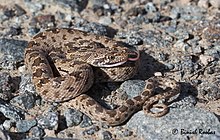Spalerosophis diadema
| Spalerosophis diadema | |
|---|---|

| |
| Israeli subspecies, Spalerosophis diadema cliffordi, commonly called Clifford's snake | |
| Scientific classification | |
| Domain: | Eukaryota |
| Kingdom: | Animalia |
| Phylum: | Chordata |
| Class: | Reptilia |
| Order: | Squamata |
| Suborder: | Serpentes |
| Family: | Colubridae |
| Genus: | Spalerosophis |
| Species: | S. diadema
|
| Binomial name | |
| Spalerosophis diadema (Schlegel, 1837)
| |
| Synonyms[2] | |
Spalerosophis diadema, known commonly as the Blotched diadem snake and the Blotched royal snake, is a species of large snake in the subfamily Colubrinae of the family Colubridae. The species is endemic to Asia and northern Africa.
Geographic range
[edit]
S. diadema is found in Algeria, Afghanistan, Egypt, northern India, Iran, Iraq, Israel,[3] Lebanon, Jordan, southern Kazakhstan, Kyrgyzstan, Libya, Mali, Mauritania, Morocco, Niger, Oman, United Arab Emirates, western Pakistan, Russia, Saudi Arabia, northern Sudan, Syria, Tajikistan, Tunisia, Turkey, southern Turkmenistan, and Uzbekistan.[2]
Subspecies
[edit]Three subspecies of S. diadema are recognized as being valid, including the nominotypical subspecies, and are found as follows.[2]
- Spalerosophis diadema cliffordi (Schlegel, 1837) – from Morocco to Egypt and Israel (Type locality: Tripoli, Libya)
- Spalerosophis diadema diadema (Schlegel, 1837) – India, Pakistan (Type locality: near "Bombay", India)
- Spalerosophis diadema schiraziana (Jan, 1865) – Zagros Mountains and the region of Bushire in western Iran, eastwards to southern Turkmenistan into Afghanistan and India; Pakistan (Type locality: Shiraz, Iran)
Etymology
[edit]The subspecific name, cliffordi, is in honor of "M[onsieur]. Clifford Cocq van Breugel " who was Dutch consul at Tripoli,[4] probably referring to Jacques Fabrice Herman Clifford Kocq van Breugel (1799-1867).
Description
[edit]S. diadema may attain a total length of 1.8 m (about 6 feet), of which about 34 cm (13½ inches) is tail. Dorsally, it is pale buff or sandy grey, with a median series of dark blotches, and smaller dark spots. Ventrally, it is usually uniform white, but rarely has small blackish spots.[5]
Reproduction
[edit]References
[edit]- ^ Els, J.; Al Johany, A.M.H.; Amr, Z.S.S.; Baha El Din, S.; Böhme, W.; Geniez, P.; Tuniyev, S.; Orlov, N.L.; Ananjeva, N.B.; Cogălniceanu, D.; Lymberakis, P.; Avci, A.; Aghasyan, A.; Tuniyev, B.; Andrén, C.; Wilkinson, J.; Üzüm, N.; Podloucky, R.; Kaya, U.; Mateo, J.A.; Hraoui-Bloquet, S.; Wilms, T.; Wagner, P.; Borkin, L.; Milto, K.; Golynsky, E.; Rustamov, A; Munkhbayar, K.; Nuridjanov, D.; Dujsebayeva, T.; Shestopal, A. (2021). "Spalerosophis diadema". IUCN Red List of Threatened Species. 2021: e.T164593A1059945. doi:10.2305/IUCN.UK.2021-1.RLTS.T164593A1059945.en. Retrieved 27 February 2022.
- ^ a b c d Species Spalerosophis diadema at The Reptile Database . www.reptile-database.org.
- ^ Academy, Reptile (2023-12-25). "Title: Understanding Spalerosophis diadema: A Comprehensive Review". מוקד לוכדי נחשים (in Hebrew). Retrieved 2023-12-25.
- ^ Schlegel (1837), p. 163 in Partie Descriptive.
- ^ Boulenger GA (1893). Catalogue of the Snakes in the British Museum (Natural History). Volume I., Containing the Families ... Colubridæ Aglyphæ, part. London: Trustees of the British Museum (Natural History). (Taylor and Francis, printers). xiii + 448 pp. + Plates I-XXVIII. (Zamenis diadema, pp. 411-413).
Further reading
[edit]- Jan G (1865). "Prime linee d'una fauna della Persia occidentale ". pp. 342–357. In: De Filippi F (1865). Note di un viaggio in Persia nel 1862. Milan: G. Daelli. 369 pp. (Periops parellellus var. schiraziana, new variety, p. 356). (in Italian).
- Marx H (1959). "Review of the colubrid snake genus Spalerosophis ". Fieldiana Zoology 39: 347–361.
- Schlegel H (1837). Essai sur la physionomie des serpens. Partie Générale. xxviii + 251 pp. AND Partie Descriptive. 606 + xvi pp. Amsterdam: M.H. Schonekat. (Coluber diadema, new species, pp. 146–147 in Partie Générale AND p. 148 in Partie Descriptive). (Coluber cliffordii, new species, pp. 148–149 in Partie Générale AND pp. 163–164 + Plate VI, figures 13 & 14 in Partie Descriptive). (in French).
- Schmidt KP (1930). "Reptiles of Marshall Field North Arabian Desert Expeditions, 1927–1928". Field Museum of Natural History Zoological Series 17 (6): 221-230 + Plate II. (Spalerosophis diadema, new combination, pp. 226–227).
- Smith MA (1943). The Fauna of British India, Ceylon and Burma, Including the Whole of the Indo-Chinese Sub-region. Reptilia and Amphibia, Vol. III.—Serpentes. London: Secretary of State for India. (Taylor and Francis, printers). xii + 583 pp. (Coluber diadema, pp. 173–175).
External links
[edit]- https://web.archive.org/web/20061213095046/http://itgmv1.fzk.de/www/itg/uetz/herp/photos/Spalerosophis_diadema.jpg
- https://web.archive.org/web/20061213094043/http://itgmv1.fzk.de/www/itg/uetz/herp/photos/Spalerosophis_d_atriceps.jpg

